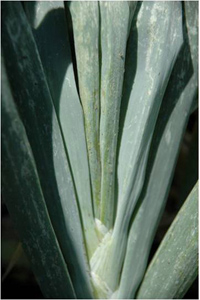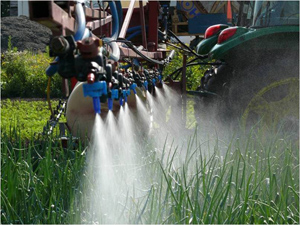Sustainable Crop Protection - Results from the Pesticide Risk Reduction Program
Context
Onion thrips, Thrips tabaci Lindeman, are economic pests of onion crops worldwide and have been identified the number one pest of onions in Canada. They feed by piercing and rasping leaf tissues, removing cell contents and leaving plants susceptible to disease. During dry, hot months, crop losses may reach over 40%, forcing growers to make two to ten insecticide applications per growing season.
Although individual thrips are easily killed with insecticides, plants may become heavily infested as local populations are able to grow exponentially in a very short period of time. Rapid increases in field populations are also caused by immigration. The tendency of thrips to congregate between new onion leaves, deep within the onion leaf axils, provides them with protection from the environment, predators and spray coverage. Studies have shown that only 1-5% of a given foliar insecticide reaches the intended target under field conditions. These factors make onion thrips control a major concern for onion growers.
Figure 1. Onion thrips damage in onion

The purpose of this project was to improve the delivery of currently registered products to the inner onion leaf axils, as this is essential to maximizing insecticide efficacy and minimizing amount of insecticides released into the environment. This is especially important with reduced-risk pesticides which possess narrower activity spectrums.
This project aimed to establish spray parameters to maximize the delivery of insecticides to the target site by identifying the most effective (1) carrier volume, (2) surfactant, and (3) nozzle angle. The project also evaluated reduced-risk pesticides as potential candidates for future data generation and registration activities. Access to newer pest control products is not only important for economic and environmental reasons; it also helps to manage resistance, which has been documented in onion thrips populations in North America.
Testing of factors affecting pesticide spray coverage
From 2007 to 2009, trials were conducted in organic soils of the Holland Marsh area of Ontario to evaluate different spray angles, surfactants, and water volumes for their ability to penetrate the crop canopy and cover the inner leaf axils. Two methods were used to assess spray coverage: water sensitive paper and an ultraviolet (UV) fluorescent dye, Tinopal. The water-sensitive paper was introduced to the plots before they were sprayed. Long paper rectangles were placed upright between the two youngest onion leaves of each plant and the fluorescent dye was dissolved in the spray tank. Plots were sprayed using a tractor-mounted sprayer with water volumes of 400, 500, and 600 L water/ha. Plots were sprayed with and without a surfactant (Sylgard 309) with nozzles at a 0° or 22° angle. Once dried, onions and water-sensitive paper were collected from each plot. The onions were photographed under a UV lamp and the papers were scanned. Images were then analysed using Assess (Image Analysis Software for Plant Disease Quantification) to determine the coverage percentage.
Figure 2. Spray coverage trials: field application of insecticides

Figure 3. Nozzle directions: vertical - 0°, and angled - 22°

Results
Analysis of the water-sensitive paper revealed that in all years, regardless of nozzle angle, more spray reached the target site (inner leaf axils) when the solution was applied in greater amounts of water (500 and 600 L/ha, compared with 400 L/ha). When nozzle angle, water volume, and surfactant were considered in combination, the top treatment for each year was applied at a 22° angle. The most effective treatments were: Sylgard 309 at 600 L/ha (2007); water at 500 L/ha (2008); and water at 600 L/ha (2009). Due to the absorbent surface of the paper rectangles, spray coverage was essentially the same with or without surfactant, thus the advantage of adding a surfactant to the spray mix could only be demonstrated on leaves.
Figure 4. Scanned Images of water-sensitive paper showing spray coverage obtained at three different spray volumes. From left to right: 400 L/ha; 500 L/ha; 600 L/ha

Analysis of spray coverage on actual onion leaves revealed that, regardless of nozzle angle, the surfactant Sylgard 309 provided better coverage than water. Additionally, using 500 or 600 L/ha provided better coverage than using 400 L/ha. When combinations were compared, the top treatment for each year was applied with Sylgard 309 at the 22° angle: 500 L/ha (2007); 600 L/ha (2008); and 600 L/ha (2009).
| Mean % Coverage | |||||||
|---|---|---|---|---|---|---|---|
| Nozzle Angle - 0° | Nozzle Angle - 22° | ||||||
| 2007 | 2008 | 2009 | 2007 | 2008 | 2009 | ||
| Surfactant | Water alone | 3.0 a | 4.2 a | 7.5 a | 3.5 a | 4.7 a | 9.8 a |
| Sylgard | 6.6 b | 8.1 b | 21.6 b | 13.6 b | 9.1 b | 26.7 b | |
| Water Volume | 400 L/ha | 1.8 a | 4.8 a | 13.8 a | 4.9 a | 4.7 a | 17.0 a |
| 500 L/ha | 4.9 b | 6.8 b | 13.3 a | 10.1 c | 7.5 b | 17.8 a | |
| 600 L/ha | 6.1 b | 6.8 b | 16.5 a | 7.6 b | 8.5 b | 20.3 a | |
| Surfactant × Water Volume |
Water only - 400 L/ha | 1.9 a | 3.2 a | 6.3 a | 1.4 a | 4.0 c | 12.2 c |
| Water only - 500 L/ha | 3.7 b | 4.1 ab | 6.9 a | 3.7 ab | 5.6 c | 9.6 c | |
| Water only - 600 L/ha | 3.5 b | 5.2 ab | 9.1 a | 5.3 b | 4.5 c | 7.5 c | |
| Sylgard + 400 L/ha | 2.5 ab | 6.3 b | 21.3 b | 12.2 c | 5.4 c | 21.8 b | |
| Sylgard + 500 L/ha | 7.6 c | 9.6 c | 19.6 b | 19.5 d | 9.4 b | 23.2 b | |
| Sylgard + 600 L/ha | 9.7 c | 8.3 bc | 23.9 b | 9.3 c | 12.4 a | 39.5 a | |
These results demonstrate that all three factors (water volume, surfactant, and nozzle angle) affect spray coverage. The one factor that had the greatest impact was water volume.
Depending on local conditions, a grower may not always be able to modify all three factors. In cases in which adding a surfactant is not feasible, increasing the amount of water as a carrier can help to improve delivery of the product to the target site. Conversely, when limitations exist regarding water volume output, adding a surfactant can increase coverage even if water volume is low.
Spraying early in the morning or later in the evening (after sunset) is another helpful tip for maximizing thrips control. Dew in the morning will help the insecticide find its way into the leaf axils where thrips typically reside. Evening spraying, when temperatures have cooled down, helps to maximize efficacy of pyrethroid insecticides.
The project also evaluated registered and non-registered reduced-risk insecticides for their efficacy in controlling onion thrips. Active ingredients that were found to be effective (spinetoram, cyantraniliprole) are currently being pursued for registration under the Minor Use Pesticides Program of AAFC . By maximizing the efficacy of insecticides, onion growers can reduce the number of applications per season and still maintain commercially acceptable levels of thrips control, benefiting growers (by reducing the cost of pest management activities), the environment, and human health - all of which are core goals of AAFC 's Risk Reduction Program.
About the Pesticide Risk Reduction at Agriculture and Agri-Food Canada
The Pesticide Risk Reduction team delivers viable solutions for Canadian growers to reduce pesticide risks in the agricultural and agri-food industry. The team achieves this goal by funding integrated pest management projects and coordinating pesticide risk reduction strategies developed through consultation with stakeholders and pest management experts. Other sustainable crop protection factsheets are available. For more information please visit the Pest Management Centre.